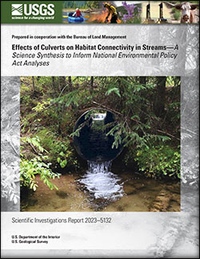Effects of Culverts on Habitat Connectivity in Streams—A Science Synthesis to Inform National Environmental Policy Act Analyses
Links
- Document: Report (9.19 MB pdf) , HTML , XML
- Related Work: Development on Ungulates and Small Mammals—A Science Synthesis to Inform National Environmental Policy Act Analyses
- Download citation as: RIS | Dublin Core
Abstract
The U.S. Geological Survey is working with Federal land management agencies to develop a series of science syntheses to support environmental effects analyses that agencies conduct to comply with the National Environmental Policy Act (NEPA). This report synthesizes science information about the potential effects of culverts on stream connectivity and subsequent effects on fish. We conducted a structured search of published scientific literature to find information about (1) culvert design, installation, and degradation; (2) methods for analyzing culvert condition and quantifying stream connectivity; and (3) the effects of changes to stream connectivity on freshwater fish. We follow the organization first established in U.S. Geological Survey Scientific Investigations Report 2023-5114, in which the report sections align with standard elements of NEPA analyses. We found that, while the effects of dams on stream biota are well documented, smaller barriers at road crossings, like culverts, are prevalent and collectively have a substantial effect on habitat connectivity. Individual culverts differ in the degree to which they impede the movement of aquatic organisms, and we documented methods to assess and estimate the permeability of a culvert, or the ability of aquatic organisms to pass through it. Finally, we outlined methods for using culvert location and permeability information to quantify connectivity in a watershed based on the Dendritic Connectivity Index. Studies have shown that channel constriction, perched outlets, and extreme flow velocities are some of the characteristics of culverts that may hinder aquatic organism passage. Culverts can serve as daily and seasonal barriers to fish, disrupting access to habitat and essential resources like cold water or overwintering refuges. Reduced connectivity can have population-level effects, leading to lower fish species richness and abundance in affected watersheds. Public land managers can use this report by incorporating it by reference in NEPA documentation, as supplemental information, or as a general reference for literature about the effects of culverts on stream connectivity and freshwater fish.
Suggested Citation
Lehrter, R.J., Rutherford, T.K., Dunham, J.B., Johnston, A.N., Wood, D.J.A., Haby, T.S., and Carter, S.K., 2024, Effects of culverts on habitat connectivity in streams—A science synthesis to inform National Environmental Policy Act analyses: U.S. Geological Survey Scientific Investigations Report 2023–5132, 21 p., https://doi.org/10.3133/sir20235132.
ISSN: 2328-0328 (online)
Table of Contents
- Acknowledgments
- Executive Summary
- Purpose of This Report
- How to Use This Report
- Science Synthesis—Effects of Culverts on Habitat Connectivity in Streams
- Methods for Developing this Science Synthesis
- References Cited
- Glossary
- Appendix 1. Option 1: “dci” R Package
- Appendix 2. Option 2: Fish Passage Extension
- Appendix 3. “dci” R Package Sample Script
| Publication type | Report |
|---|---|
| Publication Subtype | USGS Numbered Series |
| Title | Effects of culverts on habitat connectivity in streams—A science synthesis to inform National Environmental Policy Act analyses |
| Series title | Scientific Investigations Report |
| Series number | 2023-5132 |
| DOI | 10.3133/sir20235132 |
| Publication Date | February 07, 2024 |
| Year Published | 2024 |
| Language | English |
| Publisher | U.S. Geological Survey |
| Publisher location | Reston VA |
| Contributing office(s) | Fort Collins Science Center, Northern Rocky Mountain Science Center |
| Description | vii, 16 p. |
| Online Only (Y/N) | Y |


